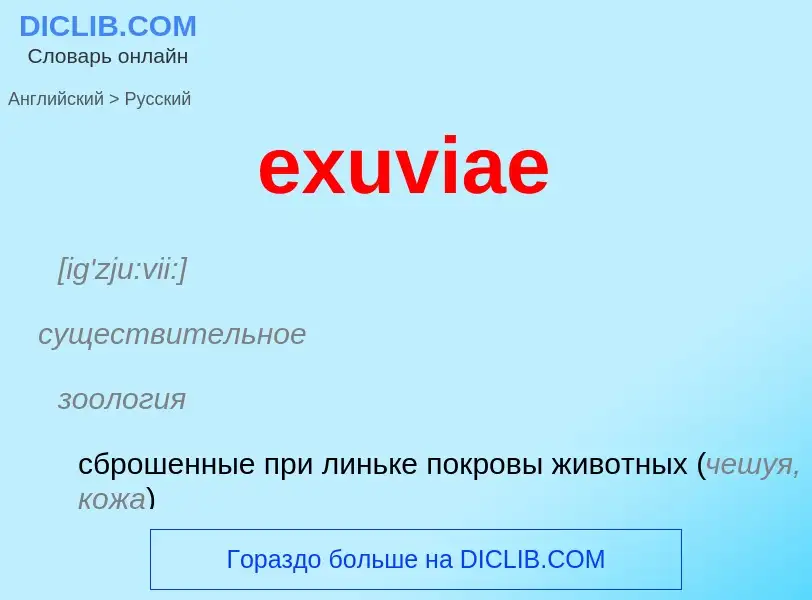Перевод и анализ слов искусственным интеллектом ChatGPT
На этой странице Вы можете получить подробный анализ слова или словосочетания, произведенный с помощью лучшей на сегодняшний день технологии искусственного интеллекта:
- как употребляется слово
- частота употребления
- используется оно чаще в устной или письменной речи
- варианты перевода слова
- примеры употребления (несколько фраз с переводом)
- этимология
exuviae - перевод на русский
[ig'zju:vii:]
существительное
зоология
сброшенные при линьке покровы животных (чешуя, кожа)
сброшенные при линьке покровы животных (кожа, чешуя)
палеонтология
ископаемые органические остатки
геология
остатки первобытной фауны
общая лексика
экзувий (сброшенная при линьке шкурка)
Определение
Википедия
In biology, exuviae are the remains of an exoskeleton and related structures that are left after ecdysozoans (including insects, crustaceans and arachnids) have moulted. The exuviae of an animal can be important to biologists as they can often be used to identify the species of the animal and even its sex.
As studying insects, crustaceans, or arachnids directly is not always possible, and because exuviae can be collected fairly easily, they can play an important part in helping to determine some general aspects of a species' overall life cycle such as distribution, sex ratio, production, and proof of breeding in a habitat. Exuviae have been suggested as a "gold standard" for insect monitoring. For instance, when monitoring dragonfly populations the presence of exuviae of a species demonstrates that the species has completed its full life cycle from egg to adult in a habitat. However, it has also been suggested that the fact that exuviae can be hard to find could lead to an underestimation of insect species compared to, for example, counting adult insects.
The Latin word exuviae, meaning "things stripped from a body", is found only in the plural. Exuvia is a derived singular form, although this is a neologism, and not attested in texts by Roman authors. A few modern works use the singular noun exuvium (e.g.). Only a single historical work by Propertius uses the singular form exuvium, but in the meaning "spoils, booty".

![''[[Anyphops]]'' ''[[Anyphops]]''](https://commons.wikimedia.org/wiki/Special:FilePath/Anyphops02.jpg?width=200)
![Cicada ''[[Platypleura]]'' Cicada ''[[Platypleura]]''](https://commons.wikimedia.org/wiki/Special:FilePath/Platypleura.jpg?width=200)

![[[Orchid mantis]] [[Orchid mantis]]](https://commons.wikimedia.org/wiki/Special:FilePath/Hymenopus coronatus MHNT Exuvie.jpg?width=200)

![Dragonfly ''[[Anax imperator]]'' Dragonfly ''[[Anax imperator]]''](https://commons.wikimedia.org/wiki/Special:FilePath/Anax imperator Exuvie MHNT Parc de la Maourine.jpg?width=200)
![[[Large milkweed bug]] [[Large milkweed bug]]](https://commons.wikimedia.org/wiki/Special:FilePath/Asclepias syriaca-Oncopeltus fasciatus-exuviae.jpg?width=200)
![Emergent [[monarch butterfly]] clinging to exuviae Emergent [[monarch butterfly]] clinging to exuviae](https://commons.wikimedia.org/wiki/Special:FilePath/Danaus plexippus emerging from chrysalis 04.jpg?width=200)
